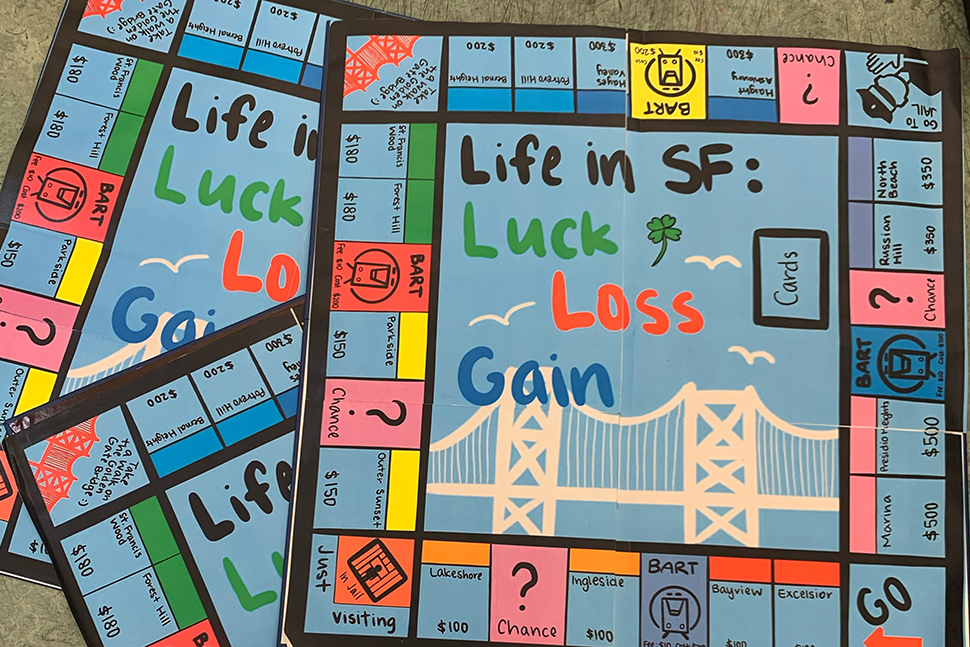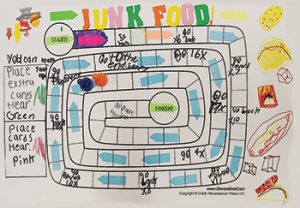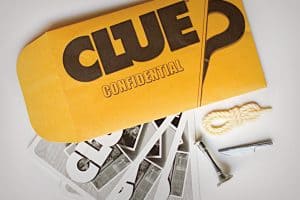
In summer 2019, teens at San Francisco Public Library (SFPL) filed into a room and sat in chairs strategically marked with dots. Depending on the color of their dot, they were categorized into one of three social classes—lower, middle, or upper.
In turn, each player’s social class determined their stakes in Life in SF: Luck, Loss, Gain, a Monopoly-esque game that simulates poverty and inequity in San Francisco, complete with properties and transit lines familiar to the group. Around the time the teens were developing the board game last year, San Francisco reported a nearly 7% surge in its homeless population from two years prior—in total, more than 8,000 unsheltered individuals in the city. “[Teens] chose the topic because they’re aware of how big the issue is,” says Marla Bergman, young adult librarian at SFPL, who facilitated the game’s creation through SFPL’s Youth Engaging in Library Leadership program.
SFPL’s program is one example of how libraries across the country are using game creation as a way to cultivate an understanding of social issues and promote self-improvement among youth. Stanford University calls this approach game design thinking and describes it as a combination of game design, human behavior, and neuroscience concepts that help participants navigate life decisions and social structures.
Advance from start
Elisabeth Gee, professor at Arizona State University in Tempe, partnered with Phoenix Public Library (PPL) from 2016 to 2018 to run a study and program called “Play in the Making,” which explored the value of game design thinking and its potential for fostering problem-solving skills in kids and teens. A specific aim of the program was to get youth interested in STEM fields.
Gee and her team instructed youth at PPL to create board games based on any educational topic, as long as they followed these basic steps: consider who will play the game, define the problem to be addressed, brainstorm the game, create a prototype, and test it with a first round.
About 150 games were developed, with subject matter that ranged from water pollution and endangered species to anxiety. Gee remembers a middle school student who created a game in which the player had to defeat monsters in order to rescue a child who couldn’t get to sleep.
“You pull a sheet up that only allows you to see part of the game, which imitates what it’d be like to be afraid of the dark, to not know what’s hiding until you get there,” Gee explains. “But you gain the skills to battle it, and it makes you more confident to overcome the monsters.”
Students at University of Chicago’s Weston Game Lab collaborated with teens at Chicago Public Library in 2019 to develop and play games with health and safety themes, such as sexual health, mental health, health disparities, and youth obesity. Ashlyn Sparrow, assistant director of the lab, remembers a group’s interest in teen pregnancy, and how its members initially believed that “once you became pregnant in high school, your life was over.”

She adds: “What it meant for them was, those teen parents could no longer hang out at the movies when they wanted to, or spend money in the ways they wanted to.” As the teens developed different pathways in the game for their players to take, their views on teen pregnancy expanded. “They said they would really like it if they could show it’s possible to graduate from high school with a baby,” Sparrow says. “I thought that was interesting because that’s the complete opposite of what they learned from society. Here we are saying your life isn’t over at all.”
In her view, games are one of the best ways to introduce and communicate ideas to youth because they mix the fun of play with more serious elements of trial and error, identity and representation, and social systems. When children and teens are empowered to create their own games, they’re able to share their own experiences.
Sparrow often asks young people whether they feel they’re represented in the games they play and what they can do while developing their own to change that. She notes that widely popular games tend to overrepresent stereotypes of marginalized groups. “Why can’t I live in this fantasy of being a powerful Black woman with natural hair, riding a dragon?”
Winning strategies
Libraries are an ideal arena for creating board games, as they often already have the necessary materials available, and programs can be budget-friendly.
“Board games are a low-tech way to attract kids into makerspaces, to introduce parents to those spaces, and to serve as a hub that scaffolds other interests and participation at the library,” Gee says. Most board games at the three libraries were made with basic art supplies or templates found online.
Sparrow says the teens who participated in her program were “comfortable and eager” with the content. She and Bergman both intended to continue their programs this year, but COVID-19 derailed these plans.
Sparrow’s advice to librarians who want to undertake a game creation program is to be involved in the ideation process as much as they can. Asking questions of the gamemakers is vital. “Your objective is to get people to think steps ahead on how the underlying systems of the games work and how it affects the world,” she says.
It’s also important for the program to be led by those participating in it, Bergman says: “The teens having come up with that initial spark, gaining momentum, and knowing about the issues in our town, knowing they could be helpful—that’s what’ll make the program successful.”


